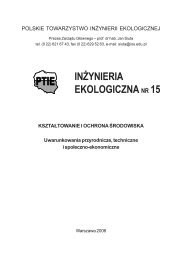Inżynieria Ekologiczna Nr 2
Inżynieria Ekologiczna Nr 2
Inżynieria Ekologiczna Nr 2
You also want an ePaper? Increase the reach of your titles
YUMPU automatically turns print PDFs into web optimized ePapers that Google loves.
168<br />
IN¯YNIERIA EKOLOGICZNA NR 2<br />
they weigh no more than one tonne when empty they can be lifted by fork-lift, small crane<br />
or earth moving equipment. Where a larger treatment capacity is required, more units are<br />
commissioned and flow through is processed serially.<br />
Each bio-reactor contains three chambers through which the water flows in succession.<br />
The first chamber acts as an oil/water separator so that any ‘free’ oil will float to the<br />
surface and any suspended solids in the water will drop to the bottom where they can be<br />
later removed as sludge. The ‘clear’ water then passes into the second aeration chamber<br />
containing a solid media on which a robust population of bacteria is established. This chamber<br />
is vigorously aerated so as to maximise the bio-degradation process and the water is ‘cleaned’<br />
biologically. The treated water from the aeration chamber then passes through a final<br />
clarification chamber before being sprayed back onto the surface of the contaminated site.<br />
The whole unit therefore acts effectively as a mobile waste water treatment plant and, if<br />
necessary, the contaminated water can be pre-treated – buffered for pH and the like – prior<br />
to contact with the bacterial mass in the aeration chamber.<br />
It is possible to pump polluted water from the surface of a harbour or expanse of water<br />
through one or more bio-reactors and progressively clean the polluted area. Contaminated<br />
ground water can be abstracted downstream of a spill site, treated by passing it through one<br />
or more bio-reactors and the re-injected upstream of the spill to effectively treat large<br />
volumes of subterranean aquifer.<br />
Where an expanse of land has been polluted with oil or diesel etc. the bio-reactor is used<br />
to treat the run-off from the polluted soil. By spraying the treated water back onto the surface<br />
of the soil, all contamination is effectively flushed out of the soil and degraded with time.<br />
A further benefit gained when using a bio-reactor on a particular site is that the ‘clean’,<br />
treated water coming out of the bio-reactor is, in itself, highly inoculated with hydrocarbon<br />
degrading bacteria. This water will effectively inoculate the water or soil onto which it is<br />
sprayed with hydrocarbon degrading bacteria, thus further accelerating the clean-up process.<br />
There are many and varied applications for bio-remediation technology where site specifics<br />
and the nature of the pollution problem define the method best suited to treating the<br />
problem most efficiently.<br />
The Future<br />
Described herein is a technology which offers a natural and therefore environmentally<br />
friendly solution to oil pollution problems throughout the world. Contaminated land and water<br />
can be effectively and economically remediated for re-use without the need for major<br />
civil works and more importantly without naively moving the contaminated material away for<br />
land filling or incineration. By using naturally occurring micro-organisms to degrade pollution<br />
in-situ the problem is naturally removed and by-products are non-toxic constituent component<br />
molecules which, in themselves, provide energy and food for other organisms.<br />
Bio-Industries Ltd. Irlandia<br />
Przedstawicielstwo w Polsce:<br />
Bio-Ecology Services Sp. z o.o. tel. (0 22) 647 39 45



